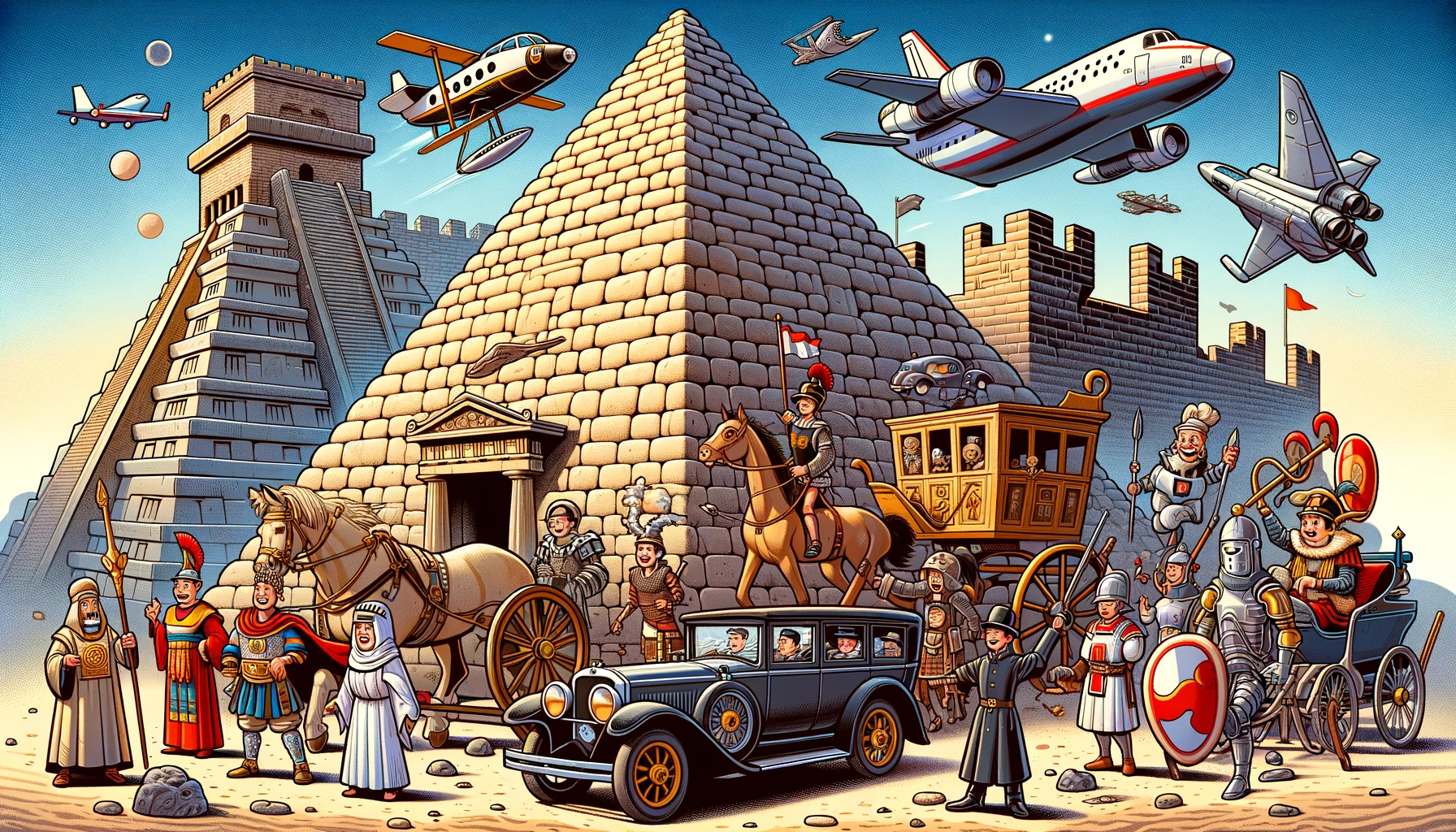Engaging Kids with History Trivia: A Fun Learning Approach
History trivia questions for kids are more than just a way to pass the time; it’s a vibrant avenue to connect young minds with the past. Understanding history is crucial for children, as it helps them make sense of the world they live in. By learning about different cultures, significant events, and historical figures, kids develop a broader perspective of the world. History also offers valuable lessons about change, progress, and the consequences of actions.
Using trivia as a tool for teaching history can significantly enhance the learning experience. It transforms the often perceived “boring” subject into an exciting adventure filled with interesting facts and stories. History trivia challenges children’s thinking, encourages curiosity, and stimulates their desire to learn more. Through fun quizzes, interactive games, and engaging discussions, kids not only learn facts but also develop critical thinking and problem-solving skills.
Moreover, history trivia can be a shared activity that fosters family bonding. Parents and children can explore historical topics together, leading to meaningful conversations and shared learning experiences. This collaborative approach to learning not only enhances knowledge but also strengthens family relationships.
In essence, history trivia questions for kids are a valuable educational tool and make for a great family trivia night. It makes history accessible and enjoyable, paving the way for a lifelong interest in learning about the past and understanding its impact on the present and future.
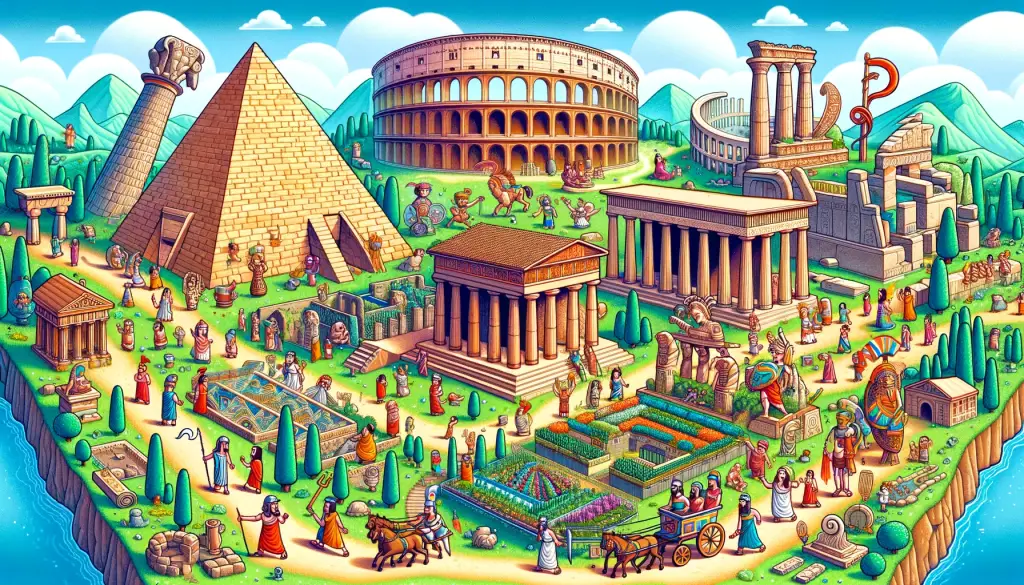
The Ancient World: A Treasure Trove of Trivia
Ancient Egypt
- What was the primary writing material used in ancient Egypt?
- Papyrus.
- Who was the first female pharaoh of Egypt?
- Hatshepsut.
- What is the largest pyramid in Egypt?
- The Great Pyramid of Giza.
- Which river was essential to ancient Egyptian life?
- The Nile River.
- What were Egyptian pyramids used for?
- Tombs for pharaohs and their treasures.
- Who discovered King Tutankhamun’s tomb?
- Howard Carter in 1922.
- What board game, still played today, originated in ancient Egypt?
- Senet.
- What did ancient Egyptians believe about cats?
- They were sacred and brought good luck.
- How did ancient Egyptians preserve bodies for the afterlife?
- By mummification.
- What is the name of the ancient Egyptian sun god?
- Ra.
Ancient Greece
- What was the center of life in ancient Greek cities?
- The Agora.
- Who was the king of the Greek gods?
- Zeus.
- What was the name of the famous temple dedicated to Athena in Athens?
- The Parthenon.
- In ancient Greece, what was an ‘Olympiad’?
- A period of four years between Olympic Games.
- Which philosopher taught Alexander the Great?
- Aristotle.
- What form of government originated in ancient Athens?
- Democracy.
- What did ancient Greeks use to write on?
- Papyrus or parchment.
- Who wrote the epic poems ‘The Iliad’ and ‘The Odyssey’?
- Homer.
- What is the famous Greek structure that still stands atop the Acropolis in Athens?
- The Parthenon.
- Which ancient Greek physician is known as the ‘father of medicine’?
- Hippocrates.
Ancient Rome
- What was the center of public life in ancient Rome?
- The Forum.
- What structure in Rome was famous for gladiator fights?
- The Colosseum.
- What language did the ancient Romans speak?
- Latin.
- Who was the first Roman Emperor?
- Augustus Caesar.
- What volcanic eruption destroyed the city of Pompeii in 79 AD?
- Mount Vesuvius.
- What was a Roman ‘aqueduct’ used for?
- To bring water to cities.
- What was the name of the Roman goddess of love and beauty?
- Venus.
- What form of government did Rome have before becoming an empire?
- A republic.
- What is the famous ancient Roman road that stretched over 50,000 miles?
- The Roman roads, with Via Appia being the most famous.
- Who was the famous Roman general who crossed the Rubicon, sparking a civil war?
- Julius Caesar.
This comprehensive list of trivia questions offers a glimpse into the ancient world, covering aspects of daily life, significant events, and prominent figures. It’s an excellent resource for engaging young minds in the fascinating world of ancient civilizations.
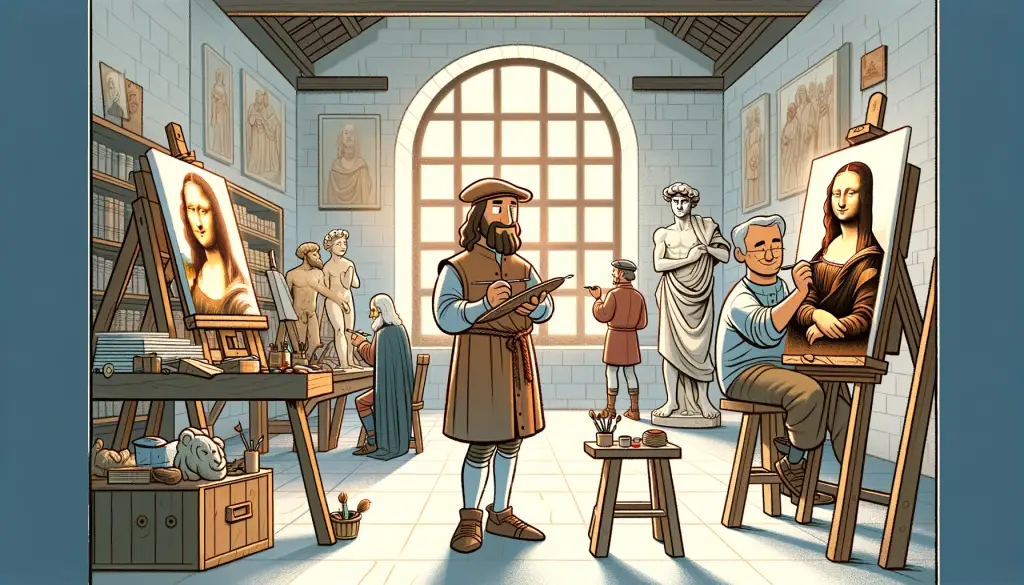
Middle Ages and Renaissance Trivia Questions For Kids
Middle Ages
- What were the Middle Ages also known as?
- The Medieval Period.
- What was the dominant architectural style of Middle Ages churches?
- Gothic.
- What was a knight’s code of honor called?
- Chivalry.
- What was the primary language used in Medieval literature?
- Latin.
- What were the series of religious wars in the Middle Ages called?
- The Crusades.
- Who was the famous king associated with the Round Table?
- King Arthur.
- What deadly plague spread through Europe in the 14th century?
- The Black Death.
- What type of armor was commonly used by knights in the Middle Ages?
- Chainmail.
- What was a ‘serf’ in medieval times?
- A peasant bound to the lord’s land.
- Which famous cathedral in France was built during the Middle Ages?
- Notre-Dame de Paris.
The Renaissance
- What does ‘Renaissance’ mean in French?
- Rebirth.
- Who painted the Mona Lisa?
- Leonardo da Vinci.
- What invention by Johannes Gutenberg revolutionized printing?
- The printing press.
- Who was the famous Renaissance playwright and poet from England?
- William Shakespeare.
- What Italian city is often called the birthplace of the Renaissance?
- Florence.
- Who sculpted the famous statue of David during the Renaissance?
- Michelangelo.
- What was Galileo Galilei known for in the Renaissance?
- His advancements in astronomy.
- Who wrote ‘The Prince,’ a famous political treatise of the Renaissance?
- Niccolò Machiavelli.
- What was the main focus of Renaissance art and learning?
- Humanism and the study of classical antiquity.
- Which famous Renaissance artist painted the ceiling of the Sistine Chapel?
- Michelangelo.
Art and Culture
- What is the term for the technique that gives depth to Renaissance paintings?
- Perspective.
- What famous Renaissance festival celebrated the end of winter?
- Carnival.
- What musical instrument gained popularity during the Renaissance?
- The lute.
- What was the primary subject of Renaissance literature?
- Human experience and individuality.
- What was the name given to the intellectual movement during the Renaissance that focused on human potential and achievements?
- Humanism.
- Who was the famous female Renaissance painter known for her portrayal of strong, heroic women?
- Artemisia Gentileschi.
- What type of dance was popular during Renaissance social gatherings?
- The pavane.
- Which architectural feature, first used in ancient Rome, was revived during the Renaissance?
- The dome.
- What new artistic technique did Renaissance artists use to create a sense of depth?
- Linear perspective.
- What was the primary language of scholarly communication during the Renaissance?
- Latin.
This curated list of questions and answers about the Middle Ages and the Renaissance offers a vivid glimpse into the rich history and cultural developments of these eras. Engaging and informative, it’s a great tool for igniting interest in these fascinating periods of human history.
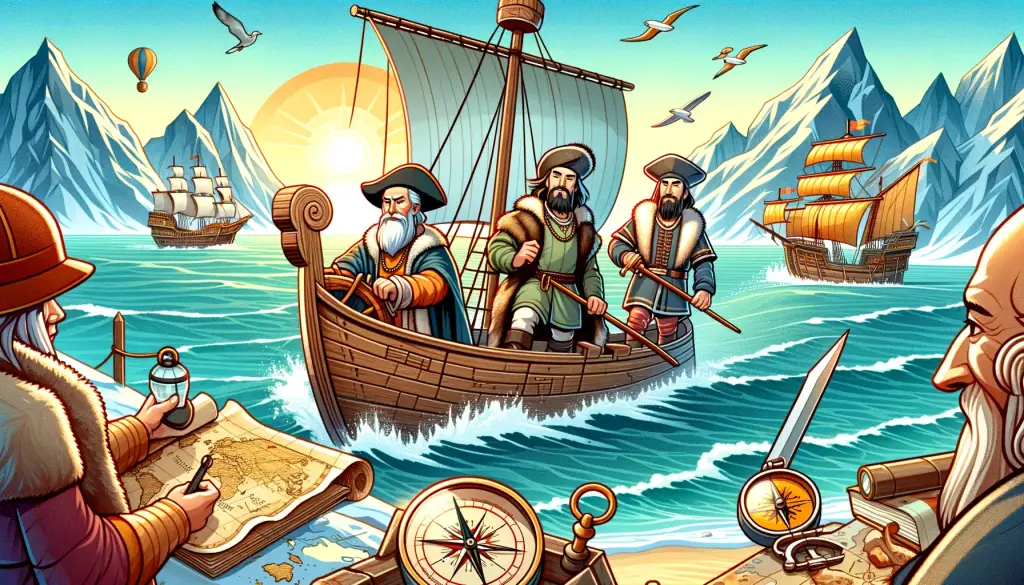
Explorers and Discoveries Trivia: Navigating New Horizons
Great Explorers Trivia Questions
- Who is credited with discovering the New World in 1492?
- Christopher Columbus.
- Which explorer was the first to circumnavigate the globe?
- Ferdinand Magellan.
- Who reached India by sea from Portugal in 1498?
- Vasco da Gama.
- Which explorer is known for his travels to China and Mongolia in the 13th century?
- Marco Polo.
- Who led the first European expedition to Florida?
- Juan Ponce de León.
- Which English explorer attempted to find a northwest passage to Asia?
- Sir John Franklin.
- Who was the first European to see the Pacific Ocean?
- Vasco Núñez de Balboa.
- Which Viking explorer is believed to have discovered Newfoundland?
- Leif Erikson.
- Who was the first person to map the coast of Australia?
- James Cook.
- Who explored the Mississippi River in 1673?
- Jacques Marquette and Louis Jolliet.
Discoveries and Impact
- What continents did Columbus originally think he had reached?
- Asia (specifically India).
- How did Magellan’s voyage change our understanding of the world?
- It proved that the Earth is round and much larger than previously thought.
- What were the Spice Islands, and why were they important?
- A group of islands rich in valuable spices, crucial for European trade.
- What new food did Europeans first get from the Americas?
- Potatoes.
- What was the Columbian Exchange?
- The widespread transfer of plants, animals, culture, human populations, technology, and ideas between the Americas and the Old World.
- How did Vasco da Gama’s route to India affect global trade?
- It opened a direct sea route, allowing Europe to bypass the land routes controlled by Middle Eastern powers.
- What was the significance of Marco Polo’s travels?
- They provided Europe with its first detailed description of Asia.
- What impact did European exploration have on indigenous populations?
- It led to the decimation of native populations due to disease, warfare, and colonization.
- What was one of the main motives for early European exploration?
- To find new trade routes and sources of wealth.
- How did the discovery of the New World affect European politics?
- It led to increased competition and conflict among European powers for colonial territories.
This list provides intriguing questions and answers about the age of exploration, highlighting the achievements of famous explorers and the profound impact of their discoveries on the world. This information not only educates but also sparks curiosity about the vast and interconnected history of global exploration.
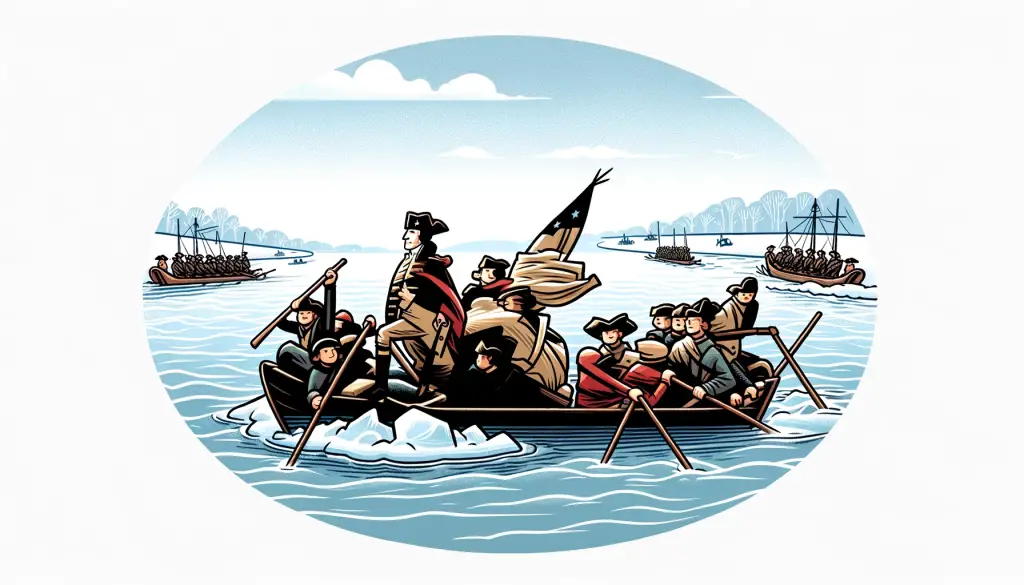
Revolution and Change Trivia Questions For Kids: Transforming the World
The American Revolution
- When did the American Revolution begin?
- 1775.
- Who wrote the Declaration of Independence?
- Thomas Jefferson.
- What was the last major battle of the American Revolution?
- The Battle of Yorktown in 1781.
- Which country helped the American colonies during the revolution?
- France.
- What was the main reason for the American Revolution?
- Resistance to British taxation without representation.
- Who was the first President of the United States?
- George Washington.
- What treaty ended the American Revolution?
- The Treaty of Paris in 1783.
- Which act imposed by Britain caused great unrest in American colonies?
- The Stamp Act of 1765.
- What event is known for the famous phrase, ‘Give me liberty, or give me death!’?
- Patrick Henry’s speech at the Virginia Convention.
- Who led the Continental Army?
- George Washington.
The French Revolution
- When did the French Revolution start?
- 1789.
- What was the symbol of the French Revolution?
- The guillotine.
- What event marked the beginning of the French Revolution?
- The Storming of the Bastille.
- Who was the king of France during the French Revolution?
- Louis XVI.
- What was the Declaration of the Rights of Man and of the Citizen?
- A fundamental document of the French Revolution that granted civil rights to some commoners.
- What led to the rise of Napoleon Bonaparte?
- The instability and power vacuum after the Revolution.
- What was the Reign of Terror?
- A period during the French Revolution when thousands were executed for ‘disloyalty’.
- What was the main cause of the French Revolution?
- Economic crisis and inequality.
- Who were the Jacobins?
- A radical political group during the French Revolution.
- What did the Women’s March on Versailles in 1789 symbolize?
- The crucial role of women in the Revolution and their discontent with the monarchy.
Impact on Modern Society and Governance
- How did the American Revolution influence other countries?
- It inspired other colonial regions to seek independence.
- What modern political concept emerged from the French Revolution?
- The notion of citizenship and popular sovereignty.
- How did the American Revolution impact the French Revolution?
- It served as a model of rebellion against a monarchy.
- What are the legacies of the French Revolution in modern governance?
- Democratic ideals and the concept of a republic.
- How did revolutions change the idea of government?
- They promoted the idea that governments should serve the people, not monarchs.
- What was a significant outcome of the American Revolution in terms of governance?
- The creation of a constitution-based federal republic.
- How did the French Revolution contribute to the rise of nationalism?
- By uniting people around the concept of a nation-state.
- What economic impacts did these revolutions have on the world?
- They led to the spread of capitalism and the decline of feudal systems.
- How did these revolutions influence global power dynamics?
- They shifted power from monarchies to the people, eventually leading to the rise of democracies.
- What was the impact of these revolutions on the concept of human rights?
- They fostered the development of rights and liberties for individuals.
This section provides a comprehensive set of questions and answers about major revolutions and their lasting impact on modern society and governance. It highlights how these pivotal events reshaped political and social structures, laying the foundations for the contemporary world.
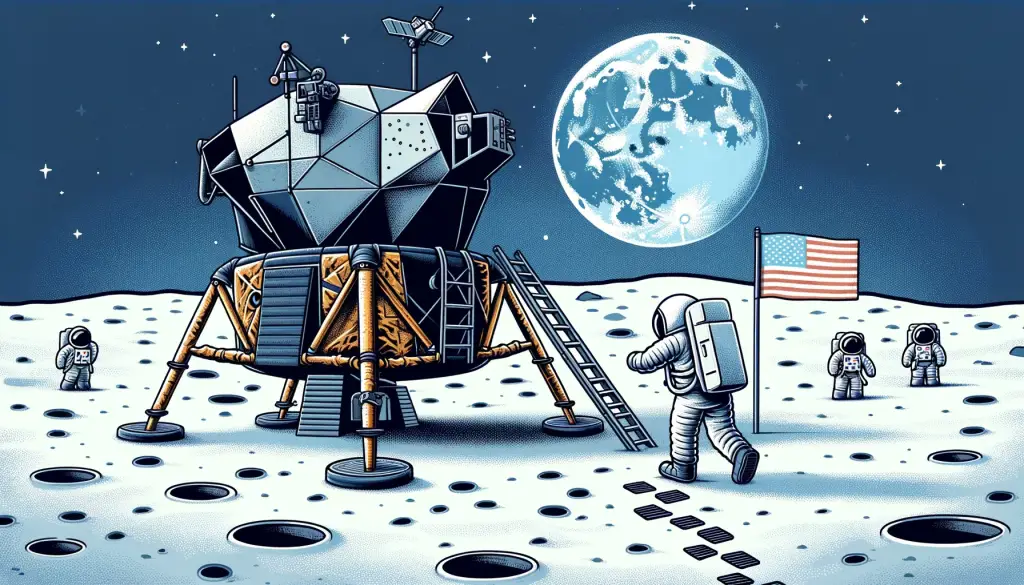
The 20th Century: A Century of Progress and Turmoil
World Wars
- When did World War I begin and end?
- 1914 to 1918.
- Who were the main participants in World War II?
- Allies (including the UK, USSR, USA) and Axis Powers (including Germany, Italy, Japan).
- What event sparked the start of World War I?
- Assassination of Archduke Franz Ferdinand of Austria.
- What was the Holocaust?
- The genocide of six million Jews by Nazi Germany during World War II.
- Which treaty ended World War I?
- The Treaty of Versailles.
- When did the United States enter World War II?
- 1941, after the Japanese attack on Pearl Harbor.
- What was the ‘Iron Curtain’?
- A metaphorical division between Western democracies and Eastern communist countries during the Cold War.
- Who was the British Prime Minister during most of World War II?
- Winston Churchill.
- What was the significance of the Battle of Stalingrad?
- A turning point in World War II, with a major Soviet victory over Nazi Germany.
- What were the atomic bombings of Hiroshima and Nagasaki?
- The USA dropped atomic bombs on these Japanese cities in 1945, leading to Japan’s surrender in World War II.
Technological Advances and Space Exploration
- When did the first human land on the Moon?
- 1969.
- Who was the first person to walk on the Moon?
- Neil Armstrong.
- What was the Cold War space race?
- A competition between the USA and USSR for dominance in space exploration.
- Which country launched the first artificial satellite, Sputnik 1?
- The Soviet Union.
- What was the first computer called?
- The ENIAC (Electronic Numerical Integrator and Computer).
- When was the first heart transplant performed?
- 1967.
- What significant medical breakthrough happened in 1953 in the field of genetics?
- Discovery of the DNA double helix structure by Watson and Crick.
- When was the Internet invented?
- The concept of a network of networks was developed in the late 1960s.
- What was the ‘Green Revolution’?
- A series of research, development, and technology transfer initiatives, occurring between the 1930s and the late 1960s, that increased agricultural production worldwide.
- When was the polio vaccine introduced?
- 1955.
Social and Political Changes
- What was the Civil Rights Movement?
- A movement for racial equality in the United States during the 1950s and 1960s.
- Who was Martin Luther King Jr.?
- A leader of the Civil Rights Movement who advocated for nonviolent protest.
- What was the significance of the Berlin Wall?
- A symbol of the Cold War, dividing East and West Berlin from 1961 to 1989.
- What was the Women’s Liberation Movement?
- A movement aiming to achieve equal rights and opportunities for women.
- When did South Africa end apartheid?
- 1991.
- What was the Cuban Missile Crisis?
- A 1962 confrontation between the United States and the Soviet Union over Soviet ballistic missiles deployed in Cuba.
- When did the Vietnam War take place?
- From 1955 to 1975.
- What was the purpose of the United Nations, founded in 1945?
- To promote international cooperation and to create and maintain international order.
- What economic system collapsed in Eastern Europe in the late 20th century?
- Communism.
- How did the 20th century change women’s roles in society?
- It saw significant progress in women’s rights, including voting rights and greater workplace participation.
This section presents a curated list of questions and answers, providing an insightful overview of the significant events, technological advancements, and social and political changes that shaped the 20th century. It highlights the pivotal moments that influenced global relations and technological progress, offering an engaging way for kids to learn about recent history.
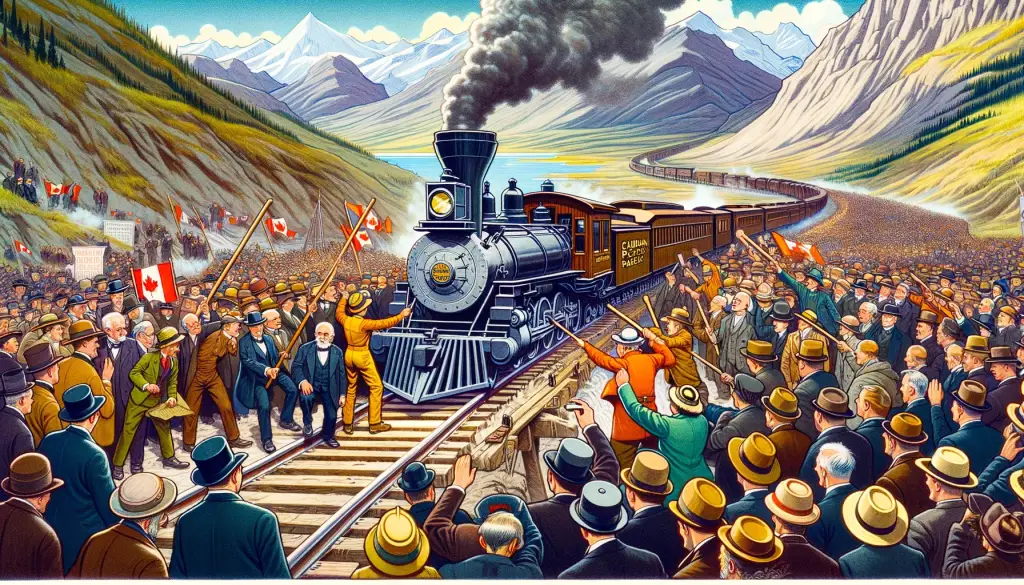
Canadian History Trivia For Kids: Celebrating a Rich Heritage
This collection of questions and answers delves into the rich tapestry of Canadian history, celebrating its indigenous heritage, the journey of confederation, and the contributions of notable Canadian figures. It offers an engaging way to explore Canada’s diverse history and cultural legacy.
Confederation and Nation-Building
- When was Canada officially recognized as a country?
- July 1, 1867.
- Who was Canada’s first Prime Minister?
- Sir John A. Macdonald.
- What was the last province to join Canada?
- Newfoundland and Labrador in 1949.
- What is the significance of the Canadian Pacific Railway?
- It united Canada from coast to coast.
- What event is celebrated on Canada Day?
- The confederation of Canada.
- Who were the Fathers of Confederation?
- Delegates who attended the Charlottetown and Quebec Conferences to discuss a union.
- What was the primary reason for the construction of the Trans-Canada Highway?
- To connect the country and promote national unity.
- What historical event is commemorated by Remembrance Day in Canada?
- The end of World War I and the sacrifice of Canadian soldiers in wars.
- What was the Quiet Revolution in Quebec?
- A period of rapid change and modernization during the 1960s.
- What is Canada’s oldest city?
- St. John’s, Newfoundland.
- Who was the first Indigenous woman to be appointed as a senator in Canada?
- Lillian Eva Dyck.
- Which Indigenous language group is the most widely spoken in Canada?
- The Cree languages.
Notable Canadian Figures
- Who is Terry Fox and what is he famous for?
- A Canadian athlete and cancer research activist who embarked on a cross-Canada run.
- Who was the first Canadian woman in space?
- Roberta Bondar.
- What Prime Minister introduced the Official Languages Act?
- Pierre Elliott Trudeau.
- Who is the famous Canadian physician known for discovering insulin?
- Frederick Banting.
- What Nobel Prize did Lester B. Pearson win and why?
- The Nobel Peace Prize for organizing the United Nations Emergency Force to resolve the Suez Canal Crisis.
- Who is a famous Canadian singer known for the song ‘Hallelujah’?
- Leonard Cohen.
- What Canadian author wrote ‘The Handmaid’s Tale’?
- Margaret Atwood.
- Who was the first Black Canadian to serve in the House of Commons?
- Lincoln Alexander.
- What sport is Wayne Gretzky associated with?
- Ice hockey.
- Who was the first woman to be appointed as the Governor General of Canada?
- Jeanne Sauvé.
This collection of questions and answers delves into the rich tapestry of Canadian history, celebrating its indigenous heritage, the journey of confederation, and the contributions of notable Canadian figures. It offers an engaging way to explore Canada’s diverse history and cultural legacy.
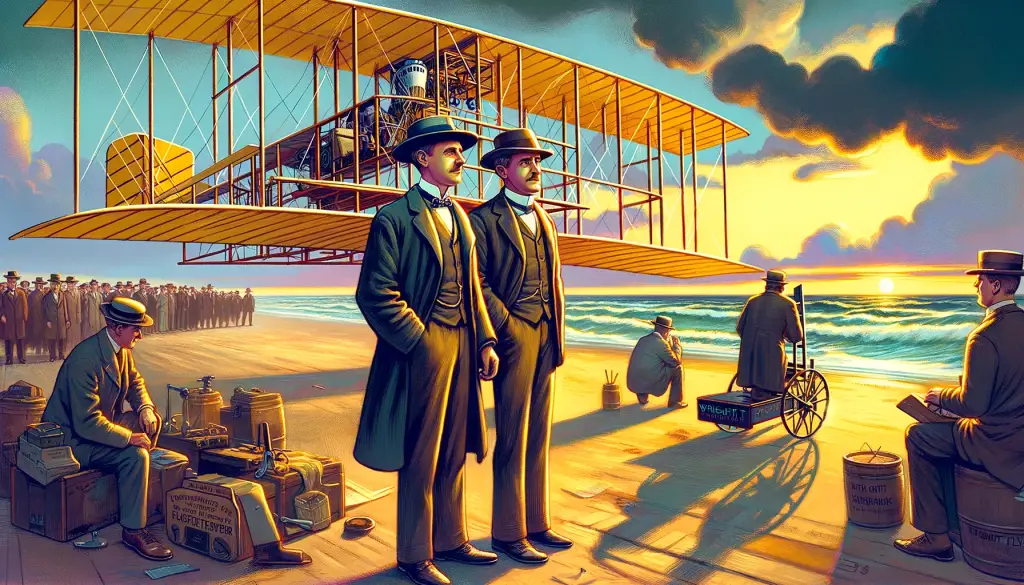
USA History Trivia Questions For Kids
Formation and Confederation
- When did the American Revolutionary War end?
- 1783.
- What was the first constitution of the United States called?
- The Articles of Confederation.
- Who wrote the U.S. Declaration of Independence?
- Thomas Jefferson.
- What year was the U.S. Constitution ratified?
- 1788.
- What was the primary cause of the American Civil War?
- Slavery and states’ rights.
- What was the outcome of the American Civil War?
- The preservation of the Union and the end of slavery.
- When was the Louisiana Purchase made, and from which country?
- 1803, from France.
- What is the significance of July 4, 1776?
- The adoption of the Declaration of Independence.
- Who was the president during the Civil War?
- Abraham Lincoln.
- What was the Underground Railroad?
- A network to help enslaved African Americans escape to freedom.
Notable American Figures
- Who is known as the ‘Father of the Constitution’?
- James Madison.
- What President is famous for the Gettysburg Address?
- Abraham Lincoln.
- Who was the first American woman in space?
- Sally Ride.
- Who was Martin Luther King Jr.?
- A prominent leader of the Civil Rights Movement.
- Who was the only U.S. President to serve more than two terms?
- Franklin D. Roosevelt.
- What inventor is known for the electric light bulb and phonograph?
- Thomas Edison.
- Who was the first African American to serve on the Supreme Court?
- Thurgood Marshall.
- Which U.S. President led the country through the Great Depression and World War II?
- Franklin D. Roosevelt.
- Who wrote the influential novel ‘Uncle Tom’s Cabin’?
- Harriet Beecher Stowe.
- What American pilot made the first solo nonstop flight across the Atlantic Ocean?
- Charles Lindbergh.
This section provides a detailed exploration of U.S. history. It offers an engaging and informative journey through the significant events and personalities that have shaped the United States.
Interactive Activities: Bringing History to Life for Kids
History Games and Quizzes
- Time Travel Adventure: Create a board game where players travel through different historical periods, collecting artifacts and learning facts to win.
- History Detective: Set up a scavenger hunt with clues based on historical events or figures. Kids solve puzzles to find the next location.
- Who Am I?: A guessing game where kids pick a historical figure’s name from a hat and give clues to others to guess who they are.
- History Bingo: Create bingo cards with historical events, figures, or symbols. Call out clues and have kids mark their cards until someone gets bingo.
History-Themed Crafts
- DIY Time Capsules: Kids can create their own time capsules with current items and predictions for the future. Bury or store them to open years later.
- Ancient Pottery Making: Using clay, kids can design and create their own pottery, inspired by ancient civilizations like the Greeks or Egyptians.
- Medieval Shields and Crests: Children design and decorate their own shields with family crests, using cardboard, paint, and other craft materials.
- Historical Figure Puppets: Using paper bags or socks, kids can make puppets of historical figures and enact famous moments from history.
Interactive Projects
- Family Tree Creation: A project where kids research and create their family tree, learning about their ancestry and significant historical events during their ancestors’ lives.
- Virtual Museum Tour: Kids can take a virtual tour of a historical museum, then create a presentation or poster about their favourite exhibit.
- Historical Skits: Children can write and perform skits based on historical events, encouraging them to delve deeper into the details and context of the event.
- Create a Historical Newspaper: Kids can create a newspaper from a specific period in history, including news articles, interviews with historical figures, and advertisements.
These activities not only make learning history fun but also enhance children’s understanding of historical contexts and their impact on the present. They encourage creativity, critical thinking, and a deeper appreciation of history.
Also Check Out:
Conclusion: The Lasting Value of History Trivia Questions for Kids
History trivia for kids is more than just a collection of facts and dates. It’s a vibrant gateway to understanding the world and how it has been shaped over time. Through engaging with history trivia, children develop a sense of curiosity and a deeper appreciation for the past. They learn about different cultures, significant events, and influential people, gaining insights into the forces that have shaped our world.
Moreover, history trivia encourages critical thinking and analytical skills. It prompts kids to question, compare, and contemplate, fostering a more profound intellectual engagement with the subject. By exploring history in a fun and interactive way, children are more likely to retain information and develop an ongoing interest in learning.
But perhaps the most significant benefit is the way history trivia can spark a lifelong love of history in young minds. By presenting the past in an accessible and entertaining format, we open the door for kids to further explore topics that interest them, whether it’s ancient civilizations, pivotal moments in their nation’s history, or the stories of people who have changed the world.
In conclusion, history trivia is a powerful tool in the educational arsenal. It combines learning with play, making history not only informative but also immensely enjoyable. We encourage kids to dive into the fascinating world of history, discover its treasures, and carry forward the lessons it has to teach us into the future.

